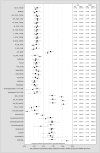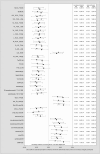Characterization of the metabolic profile associated with serum 25-hydroxyvitamin D: a cross-sectional analysis in population-based data
- PMID: 27605587
- PMCID: PMC5100623
- DOI: 10.1093/ije/dyw222
Characterization of the metabolic profile associated with serum 25-hydroxyvitamin D: a cross-sectional analysis in population-based data
Abstract
Background: Numerous observational studies have observed associations between vitamin D deficiency and cardiometabolic diseases, but these findings might be confounded by obesity. A characterization of the metabolic profile associated with serum 25-hydroxyvitamin D [25(OH)D] levels, in general and stratified by abdominal obesity, may help to untangle the relationship between vitamin D, obesity and cardiometabolic health.
Methods: Serum metabolomics measurements were obtained from a nuclear magnetic resonance spectroscopy (NMR)- and a mass spectrometry (MS)-based platform. The discovery was conducted in 1726 participants of the population-based KORA-F4 study, in which the associations of the concentrations of 415 metabolites with 25(OH)D levels were assessed in linear models. The results were replicated in 6759 participants (NMR) and 609 (MS) participants, respectively, of the population-based FINRISK 1997 study.
Results: Mean [standard deviation (SD)] 25(OH)D levels were 15.2 (7.5) ng/ml in KORA F4 and 13.8 (5.9) ng/ml in FINRISK 1997; 37 metabolites were associated with 25(OH)D in KORA F4 at P < 0.05/415. Of these, 30 associations were replicated in FINRISK 1997 at P < 0.05/37. Among these were constituents of (very) large very-low-density lipoprotein and small low-density lipoprotein subclasses and related measures like serum triglycerides as well as fatty acids and measures reflecting the degree of fatty acid saturation. The observed associations were independent of waist circumference and generally similar in abdominally obese and non-obese participants.
Conclusions: Independently of abdominal obesity, higher 25(OH)D levels were associated with a metabolite profile characterized by lower concentrations of atherogenic lipids and a higher degree of fatty acid polyunsaturation. These results indicate that the relationship between vitamin D deficiency and cardiometabolic diseases is unlikely to merely reflect obesity-related pathomechanisms.
Keywords: 25(OH)D; metabolomics; molecular epidemiology; obesity; vitamin D.
© The Author 2016. Published by Oxford University Press on behalf of the International Epidemiological Association.
Figures


Similar articles
-
Serum 25(OH)D and adipokines levels in people with abdominal obesity.J Steroid Biochem Mol Biol. 2018 Jan;175:170-176. doi: 10.1016/j.jsbmb.2016.09.005. Epub 2016 Sep 11. J Steroid Biochem Mol Biol. 2018. PMID: 27629594
-
Associations between abdominal fat and body mass index on vitamin D status in a group of Spanish schoolchildren.Eur J Clin Nutr. 2010 May;64(5):461-7. doi: 10.1038/ejcn.2010.26. Epub 2010 Mar 10. Eur J Clin Nutr. 2010. PMID: 20216565
-
Metabolomics analysis of serum 25-hydroxy-vitamin D in the Alpha-Tocopherol, Beta-Carotene Cancer Prevention (ATBC) Study.Int J Epidemiol. 2016 Oct;45(5):1458-1468. doi: 10.1093/ije/dyw148. Epub 2016 Aug 14. Int J Epidemiol. 2016. PMID: 27524818 Free PMC article.
-
Vitamin D deficiency in relation to general and abdominal obesity among high educated adults.Eat Weight Disord. 2019 Feb;24(1):83-90. doi: 10.1007/s40519-018-0511-4. Epub 2018 May 31. Eat Weight Disord. 2019. PMID: 29856006
-
Vitamin D and metabolic health with special reference to the effect of vitamin D on serum lipids.Prog Lipid Res. 2011 Oct;50(4):303-12. doi: 10.1016/j.plipres.2011.05.001. Epub 2011 May 27. Prog Lipid Res. 2011. PMID: 21640757 Review.
Cited by
-
Quantitative Serum Nuclear Magnetic Resonance Metabolomics in Large-Scale Epidemiology: A Primer on -Omic Technologies.Am J Epidemiol. 2017 Nov 1;186(9):1084-1096. doi: 10.1093/aje/kwx016. Am J Epidemiol. 2017. PMID: 29106475 Free PMC article. Review.
-
Circulating 25-hydroxyvitamin D, nasopharyngeal airway metabolome, and bronchiolitis severity.Allergy. 2018 May;73(5):1135-1140. doi: 10.1111/all.13379. Epub 2018 Feb 5. Allergy. 2018. PMID: 29315663 Free PMC article.
-
Plasma 25-Hydroxyvitamin D Concentrations are Associated with Polyunsaturated Fatty Acid Metabolites in Young Children: Results from the Vitamin D Antenatal Asthma Reduction Trial.Metabolites. 2020 Apr 14;10(4):151. doi: 10.3390/metabo10040151. Metabolites. 2020. PMID: 32295265 Free PMC article.
-
Vitamin D status modulates innate immune responses and metabolomic profiles following acute prolonged cycling.Eur J Nutr. 2023 Oct;62(7):2977-2990. doi: 10.1007/s00394-023-03181-1. Epub 2023 Jul 17. Eur J Nutr. 2023. PMID: 37458775 Free PMC article.
-
Metabolomics-based profiles predictive of low bone mass in menopausal women.Bone Rep. 2018 Jun 18;9:11-18. doi: 10.1016/j.bonr.2018.06.004. eCollection 2018 Dec. Bone Rep. 2018. PMID: 29955645 Free PMC article.
References
-
- Plum LA, DeLuca HF. The functional metabolism and molecular biology of vitamin D action. In: Holick MF. (ed). Vitamin D - Physiology, Molecular Biology, and Clinical Applications. 2nd edn New York, NY: Humana Press, 2010.
-
- Holick MF. Vitamin D and health: evolution, biologic functions, and recommended dietary intakes for vitamin D. In: Holick MF. (ed). Vitamin D Physiology, Molecular Biology, and Clinical Applications. 2nd edn New York, NY: Humana Press, 2010.
MeSH terms
Substances
Grants and funding
LinkOut - more resources
Full Text Sources
Other Literature Sources
Medical

